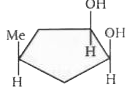Which of the following compounds is non-polar ?
CCl4
CH2Cl2
CHCl3
CH3Cl
The correct Answer is:A
To determine which of the given compounds is non-polar, we will analyze each option based on the concept of dipole moment. A non-polar molecule has a net dipole moment of zero, meaning that the individual dipole moments cancel each other out.
1. Understanding Polar and Non-Polar Molecules:
- A polar molecule has a dipole moment due to a difference in electronegativity between atoms, leading to charge separation.
- A non-polar molecule has no net dipole moment, meaning the dipole moments cancel each other out.
2. Analyzing the Options:
- Option 1: CCl4 (Carbon Tetrachloride):
- Structure: Central carbon atom bonded to four chlorine atoms.
- Electronegativity: Chlorine is more electronegative than carbon.
- Dipole Moments: Each C-Cl bond has a dipole moment directed from carbon (positive) to chlorine (negative).
- Result: The four dipole moments are equal in magnitude and symmetrically arranged, thus they cancel each other out. Therefore, CCl4 is non-polar.
- Option 2: CH2Cl2 (Dichloromethane):
- Structure: Central carbon atom bonded to two hydrogen atoms and two chlorine atoms.
- Dipole Moments: The C-H bonds have a dipole moment directed from carbon (negative) to hydrogen (positive), and the C-Cl bonds have a dipole moment directed from carbon (positive) to chlorine (negative).
- Result: The dipole moments do not cancel out due to the asymmetrical arrangement, making CH2Cl2 polar.
- Option 3: CHCl3 (Chloroform):
- Structure: Central carbon atom bonded to one hydrogen and three chlorine atoms.
- Dipole Moments: Similar to CH2Cl2, the C-H bond has a dipole moment directed from carbon (negative) to hydrogen (positive), while the C-Cl bonds have dipole moments directed from carbon (positive) to chlorine (negative).
- Result: The dipole moments do not cancel out, making CHCl3 polar.
- Option 4: CH3Cl (Methyl Chloride):
- Structure: Central carbon atom bonded to three hydrogen atoms and one chlorine atom.
- Dipole Moments: The C-H bonds have dipole moments directed from carbon (negative) to hydrogen (positive), and the C-Cl bond has a dipole moment directed from carbon (positive) to chlorine (negative).
- Result: The dipole moments do not cancel out, making CH3Cl polar.
3. Conclusion:
- After analyzing all options, we find that the only non-polar compound is CCl4 (Option 1).
Final Answer:
The non-polar compound is CCl4.
- A polar molecule has a dipole moment due to a difference in electronegativity between atoms, leading to charge separation.
- A non-polar molecule has no net dipole moment, meaning the dipole moments cancel each other out.
- Option 1: CCl4 (Carbon Tetrachloride):
- Structure: Central carbon atom bonded to four chlorine atoms.
- Electronegativity: Chlorine is more electronegative than carbon.
- Dipole Moments: Each C-Cl bond has a dipole moment directed from carbon (positive) to chlorine (negative).
- Result: The four dipole moments are equal in magnitude and symmetrically arranged, thus they cancel each other out. Therefore, CCl4 is non-polar.
- Structure: Central carbon atom bonded to two hydrogen atoms and two chlorine atoms.
- Dipole Moments: The C-H bonds have a dipole moment directed from carbon (negative) to hydrogen (positive), and the C-Cl bonds have a dipole moment directed from carbon (positive) to chlorine (negative).
- Result: The dipole moments do not cancel out due to the asymmetrical arrangement, making CH2Cl2 polar.
- Structure: Central carbon atom bonded to one hydrogen and three chlorine atoms.
- Dipole Moments: Similar to CH2Cl2, the C-H bond has a dipole moment directed from carbon (negative) to hydrogen (positive), while the C-Cl bonds have dipole moments directed from carbon (positive) to chlorine (negative).
- Result: The dipole moments do not cancel out, making CHCl3 polar.
- Structure: Central carbon atom bonded to three hydrogen atoms and one chlorine atom.
- Dipole Moments: The C-H bonds have dipole moments directed from carbon (negative) to hydrogen (positive), and the C-Cl bond has a dipole moment directed from carbon (positive) to chlorine (negative).
- Result: The dipole moments do not cancel out, making CH3Cl polar.
- After analyzing all options, we find that the only non-polar compound is CCl4 (Option 1).
The non-polar compound is CCl4.
Topper's Solved these Questions
- CHEMICAL BONDING AND MOLECULAR STRUCTURE Book:AAKASH INSTITUTE ENGLISHChapter:CHEMICAL BONDING AND MOLECULAR STRUCTURE Exercise:Assignment Section - C Objective Type Questions(More than one options are correct )
Explore 13 Videos
- CHEMICAL BONDING AND MOLECULAR STRUCTURE Book:AAKASH INSTITUTE ENGLISHChapter:CHEMICAL BONDING AND MOLECULAR STRUCTURE Exercise:Assignment Section - D (Linked Comprehension Type Questions)
Explore 12 Videos
- CHEMICAL BONDING AND MOLECULAR STRUCTURE Book:AAKASH INSTITUTE ENGLISHChapter:CHEMICAL BONDING AND MOLECULAR STRUCTURE Exercise:Assignment Section -A Objective Type Questions (One option is correct)
Explore 60 Videos
- BIOMOLECULESBook:AAKASH INSTITUTE ENGLISHChapter:BIOMOLECULESExercise:EXERCISE (ASSIGNMENT) SECTION - D Assertion - Reason Type Questions
Explore 5 Videos
- CHEMICAL KINETICSBook:AAKASH INSTITUTE ENGLISHChapter:CHEMICAL KINETICSExercise:ASSIGNMENT (SECTION D : Assertion - Reason Type Questions)
Explore 15 Videos
Similar Questions
Knowledge Check
Which of the following compound is non-resovable (meso) compounds ?
A B
B C
C DAll of these
DAll of theseWhich of the following compounds is non aromatic ?
A B
B C
C D
D
Which of the following compound is planar and non-polar ?
View SolutionWhich of the following compound (s) is/are non-polar?
View SolutionWhich of the following compound (s) is/are non-polar?
View SolutionWhich of the following species is non- polar ?
View SolutionWhich of the following molecule is non-polar & planar ?
View SolutionWhich one of the following compounds is non - benzenoid ?
View Solution